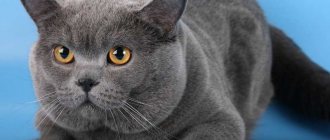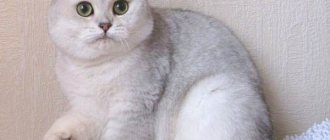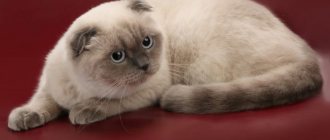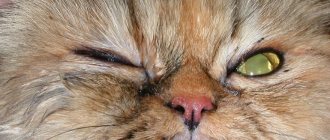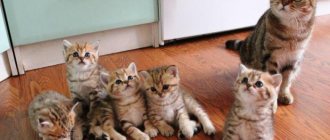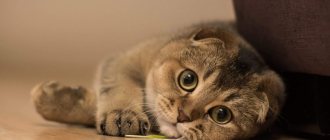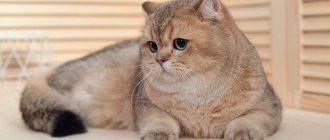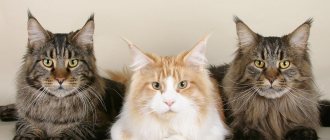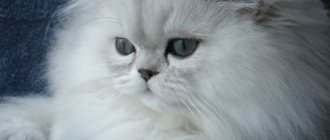Do you want to find a cute pet with a soft, affectionate character that will fill your home with love and warmth? The British chinchilla will become such a faithful friend.
Chinchillas are famous for their amazing fur color, which is bred from British, Persian and Scottish cats. The color of the fur is similar to that of the rodent of the same name. The coats of these cute cats are silver, gold or shaded.
Brief information:
- Name: British chinchilla;
- Year of breeding: 1880s;
- Country of breeding: Great Britain;
- Weight: from 4 to 8 kg;
- Height: height at withers 28-30 cm
- Life expectancy: about 15 years.
Keeping a pet
Keeping a chinchilla in the house will lead to minor problems, because their long and thick coat requires constant attention and care.
Aristocratic chinchillas will require care and attention
Nutrition
You can feed your cat in two common ways: natural food or food sold in pet stores.
If you choose natural food, then the best options are:
- chicken, rabbit, turkey: serve the meat either raw or scalded with boiling water, the main thing is that it is finely chopped;
- fish: no more than one or two times a week, only sea fish and only boiled;
- dairy products: it is enough to give no more than twice a week, preference is given to kefir, yogurt, low-fat cottage cheese.
When choosing dry food, it is best to contact a veterinarian, he will take into account all the physiological needs of the pet - height, age, tendency to obesity.
Chinchillas are fed 2-3 times a day. If you plan to participate in exhibitions, then two weeks before the exhibition itself, the cat should be fed kitten food, which is enriched with vitamins and proteins: thanks to it, the coat will look amazing.
Caring for your pet's appearance
The most difficult and necessary thing is to care for the thick and often very long hair of a chinchilla. She needs constant combing, preferably every day, but once every two days is possible, otherwise she will have to cut out the mats. It is recommended to first go through the hair growth with a comb, then against its growth.
It is advisable to brush chinchillas daily
Chinchillas, like many other breeds, are opponents of bathing, and besides, bathing can cause the coat to turn yellow and lose all its charm. To keep the coat snow-white, breeders advise using specialized whitening shampoos for cats.
If the paws and face become dirty, you should wipe them with a damp cloth.
Chinchilla ears do not require special care; it is enough to wipe them once a week using a cotton swab. But the eyes of pets are subject to increased lacrimation, so you need to regularly wipe them using soft, damp wipes.
The huge eyes of chinchillas are subject to increased lacrimation.
It is imperative to accustom kittens to a scratching post from early childhood, however, despite this, once every 1–2 weeks, using special nail clippers, one third of the upper part of the pet’s claw should be trimmed. Do this extremely carefully so as not to accidentally cut off the chinchilla’s blood vessels running in the inner part of the claw.
Other care and maintenance features
Walking chinchillas is possible, but not necessary. In the city, this should only be done with a harness, but if you live in a house outside the city, you can let the cat go for a walk in the garden alone, after making sure that there are no objects in the area that are dangerous to his life. The main thing is not to forget to put an anti-parasitic collar on your pet.
It is necessary to ensure that your pet's tray is always clean and odorless. Buy filler that is suitable specifically for your home, change it as needed. If you take good care of the litter box, the animal will never cause mischief outside of it.
You can choose any filler for the tray, for example, eco-friendly wood
Choosing a kitten
There are quite a lot of advertisements from private owners on websites and electronic boards with offers to choose a chinchilla cat. They offer to buy a British shorthair chinchilla cat for almost pennies: from 1-2 thousand rubles. Usually for this price you get a pet without documents or pedigree.
The buyer cannot be sure of the baby’s excellent health and does not know in what conditions the kitten grew up before the sale. Unscrupulous sellers breed incompatible samples and do not monitor the breed standard. All this leads to disastrous consequences: illness and death of animals.
At a young age, it is not clear what color a cat will have. The seller will try to assure the presence of this or that breed, and on an older ward it will be difficult to see the supposed promised signs of the animal’s standard. The formation of the animal is completed by 1 year and 6 months of life.
Therefore, it is necessary to contact nurseries and clubs, experienced breeders. Advantages of a kitten purchased from a nursery:
- a metric is provided;
- you can see the baby’s parents: in the nursery or from a photograph, evaluate their appearance and behavior;
- the animal will receive all vaccinations strictly according to age;
- the pet will be treated for helminths;
- the baby is trained to the tray;
- the baby is trained in hygiene skills;
British chinchillas quickly get used to going to the toilet in a designated place.
The price of a kitten from an experienced breeder consists of the cost of caring for the animal, purchasing medications and household products. Owners travel abroad for some representatives of the breed: travel plus hotel accommodation require considerable expenses. Participation in exhibitions and mating, selection of a partner for crossing - all this involves costs, sometimes not only material, but also emotional. Every baby is loved and the fate of every member of the nursery worries the owner.
At what age is it better to adopt a kitten?
Before 2 months, professional clubs do not offer kittens for sale. Until this time, the baby should be with the mother. The best food for a newborn kitten is cat's milk. A baby who was taken away from a cat prematurely is not psychologically ready for independent life. Nursery staff jealously monitor the date of the expected departure of the ward to a new habitat. To prevent painful situations, it is unacceptable to take animals away immediately after birth: this will lead to the death of the pet.
Kittens up to one year old are offered at the maximum price. In Moscow, a baby British golden chinchilla can be seen at a price of 25 thousand rubles and more. Some pets are considered up to 70 thousand rubles.
It is not difficult to find a silver British chinchilla kitty in a nursery at a cost of 25-35 thousand rubles. Adult cats that do not participate in exhibitions due to age and have completed their breeding career are offered for a symbolic amount, sometimes in the region of one thousand or two thousand rubles. But it will be a well-groomed, vaccinated, healthy animal.
Chinchilla cat breeds
Silver and golden ticked colors did not spread to all domestic animals, but remained in the arsenal of a limited number of cat breeds.
Persian
Iranian Persians became the founders of a new trend. They were even called chinchillas for some time in Europe. They had a residual pattern, and selection was carried out in the direction of completely shading tabby traits. Moreover, the breeders were never able to remove the pattern on the tail, which significantly reduced the value of breeding such cats.
Experts tried to achieve the whitest possible root area in chinchilla cats in order to blur the boundaries of the pattern that appears at the ends of the coat.
British chinchillas
Among the British it is silver and is quite common. It successfully competes with the gray-blue color, which is considered the main color for this breed. The ancestors of these chinchillas were Persian and British smoky cats.
Scottish Scottish Chinchillas
Scottish Fold cats were at one time considered a subspecies of the British breed. They also took part in the development of a new color, but entered this path later than the others. Therefore, the Scots avoided the “childhood” diseases of early selection and obtained the most successful variants of genetic combinations.
The Scottish Fold is interesting because it has its own breed genetic mutation, which manifests itself in the unusual structure of the ears. But since the instructions for chinchilla color are transmitted by other genes, such a synthesis did not in any way affect the overall breed qualities.
The color of Scottish cats with chinchilla color is considered one of the most successful and stable. Unlike representatives of the British breed, among the Scots there are rarely animals rejected from breeding.
How to choose a British chinchilla and where to buy
Nowadays there are a lot of advertisements for the sale of chinchilla kittens on the Internet from private owners and from professional nurseries. Regardless of where you buy, do not adopt a kitten before 2 months of age. The best food for a baby during this period is cat's milk. An earlier purchase can have a negative impact on the kitten’s health and even lead to its death.
When choosing a British chinchilla, make sure that the kitten:
- active and inquisitive;
- no discharge from the eyes, nose, mouth;
- has shiny fur;
- without breed defects.
Why do many breeders recommend buying a British chinchilla from a nursery:
- Cats with good genetics participate in breeding, because... If a kitten exhibits any disease or breed defect, it is immediately removed from breeding.
- All kittens in the nursery are required to be vaccinated.
- Tests are done for the presence of genetic diseases, i.e. you get a guaranteed healthy kitten.
- It is necessary to have an animal passport confirming the breed of the kitten.
Prices for chinchilla kittens largely depend on the availability of documents and compliance with the breed. The color of the kitten also has a great influence on the cost of a British chinchilla. A golden chinchilla is more valuable than a cat with silver fur.
Castration and sterilization
If you do not intend to breed offspring, then you should think about castration and sterilization of your pet.
Castration is the complete removal of the gonads of representatives of both sexes: removal of the testes in males and ovaries in females through surgery.
Sterilization is a more gentle procedure in which the veterinarian ties the vas deferens in cats and the fallopian tubes in females. This procedure will not discourage sexual desire in pets, but they will not be able to reproduce.
At what age is it recommended to do it?
Many experts say that the sooner this operation is performed, the better. Others believe that it is harmful for the pet, preferably later, at the age of 2-3 years.
Caring for your pet after surgery
For the first 6–12 hours after surgery, feeding your pet is strictly prohibited to avoid the gag reflex. You can only give water. After returning home, the pet should be placed on a towel in a comfortable, warm place, protected from drafts. You should not place your pet on elevated surfaces, as after anesthesia he will be disoriented and may fall. Cats wear a special bandage to protect the sutures for several days after surgery.
Postoperative blankets protect the cat's stitches
Characteristics and color features
Regardless of the breed, chinchilla cats should have hair with a smooth color transition from soft pink to dark at the tips. The undercoat can be of different shades: from light peach to red. There should be no dull or grayish areas on the body.
The color is considered chinchilla if the dark tip occupies 1/8 of the length of the hair. If 1/3 is painted, the color is called shaded, if 1/2 is called golden tabby.
In chinchillas, the pigmentation of the iris is usually green or bluish-green. There is a dark brown or black edging on the eyelids, lips and nose. The lobe is colored pink, the paw pads are black or brown.
Information about the breed and color of the cat is indicated in the pedigree. Special designations are used for this.
- BRI - British;
- PER – Persian;
- SFL – Scots Fold Shorthair;
- SFS – long-haired Scots Fold;
- SCS – Scots with erect ears, shorthair;
- SCL – long-haired, erect-eared Scotsman.
- y – golden;
- a – blue;
- b – chocolate;
- c – lilac;
- n – black;
- o– cinnamon;
- q – faun.
- 11 – shaded;
- 12 – chinchilla;
- 21 – linx (tabby pattern on the face and paws);
- 22 – marble;
- 23 – brindle;
- 24 – spotted;
- 25 – ticked (each hair has more than two dark zones);
- 33 – point (reminiscent of the Siamese color).
At the end they put numbers indicating eye color:
For example, a Scottish fold short-haired chinchilla of golden color with black tips of hairs and green eyes would be written as follows: SFLny 12 64.
Education and training
Chinchillas need to be raised and trained using the same methods as all cats, but taking into account the individual characteristics of each breed. Mandatory skills and abilities that the animal must master by the age of one year:
- the ability to respond to one’s own nickname;
- go to the toilet and sharpen your claws in a strictly designated place;
- observe the sleeping and feeding schedule, do not wake the owner at night;
- sit calmly in the owner's arms;
- adequately perceive the need for transportation: traveling in a carrier bag, traveling by car.
Owners of show pets will also have to work on the technique of displaying the animal at an exhibition. Since both the British, the Persians, and the Scottish have a compact body, in the ring they are not exhibited “stretched” like Orientals, but in a grouped state. Preparation for this action is considered to be the development in the cat of the habit of sitting on the laps and hands of the owner, as well as patiently accepting changes in posture at the insistence of the person.
Persian chinchillas are intelligent and highly intelligent cats, grasping basic cat wisdom on the fly. For example, by 1-1.5 months, kittens go to the litter tray quite carefully. Often, if babies live with their mother or another adult cat, they don’t even need to be taught this skill - the furballs independently copy the behavior of the older pet.
Young and even slightly mature chinchillopers retain a lively interest and curiosity in things they see for the first time, so at first you will have to hide indoor plants, toxic detergents and cleaners, as well as the wires of household appliances from the animal. The breed does not produce any destructive actions - chinchillas do not scratch furniture (provided that there is a normal scratching post in the house), they do not rummage through the owner’s plates, and they do not take away piece by piece a newspaper forgotten by the bed.
At the beginning of socialization, it is important for a kitten in a new home to create a peaceful atmosphere, so try to make less noise in the presence of the baby and warn your household about this. Classes should be carried out taking into account the chinchilla’s biorhythms: in the mornings and afternoons, cats are inactive and prefer to take a nap
And of course, keep in mind that not a single pet is capable of multitasking, so if you decide to practice one command, finish what you started without switching to teaching your furry other useful skills.
Chinchillas from the British and Scottish clans are hampered in their studies by natural shyness and timidity. These comrades are generally frightened by everything new and unknown, so during lessons, talk more with your pet in an even, calm voice. A chinchilla doing dirty tricks is such a rare phenomenon that not every owner of the breed manages to see it. If, nevertheless, the pet is drawn to the “scratchers” or the dining table, influence the animal with its own fears. Suddenly clap your hands or secretly splash water on the furry criminal - then you can only watch how the chinchilla coward quickly runs away from the crime scene, turning into a quiet good boy.
Character
British chinchilla cats are distinguished by aristocratic manners, calmness, and a good nervous system. Up to a year old, babies are very active and love to play. Adult pets are most often balanced and treat their owner as a friend. The British do not like to sit on their hands; they prefer to approach them themselves for a portion of affection.
Animals understand the situation very well and are able to manipulate the owner and family members. Plush beauties most often cannot stand strangers; there are known cases of hostility towards drunken visitors to the house. But by purchasing a British chinchilla cat, a person receives a devoted companion. The pet is attached to the house and can resort to tricks if the owner is forced to say goodbye to it. Sometimes they hide or pretend to be sick when strangers appear.
British Chinchillas get along well with other pets indoors. But the arrival of a new pet must be planned. It is necessary to separate the arriving baby from the old friend. Gradually allow animals to be together. If you do not provide for the behavior of pets, you can get sick and sick in cats.
British chinchillas are prone to depression. They buy toys and mazes for the animal. A mobile, active pet eats well and looks great.
The description of the breed and character of the British chinchilla shows: pets get along well with children. But you should not allow your child to squeeze and knead the baby immediately after coming into the house. The furry baby is given time to get used to the new home, food, smells and sounds.
Long-lived domestic cats
The record holder for life expectancy is a cat named Lucy, who lives in the UK. According to official data, she is 43 years old. Translating to our human age, it turns out that the cat is almost 175 years old. In second place is the cute cat Cream Puff, originally from the USA, who lived a happy life at the age of 38, leaving this world in 2005.
Well, in third place among long-livers among mustachioed fluffy pets is a cat who once lived in Devon (England). He lived happily until his 36th birthday, after which he calmly passed away. By the way, the mentioned animals are Guinness Book record holders in the section of long-livers among domestic cats.
Scottish chinchilla, comparison with the golden chinchilla breed, features of the breed
The Scottish chinchilla (cat/cat) differs in character from other representatives of the subspecies. The ears should be compact, lop-eared and tilted forward in accordance with the breed standard.
The coat is medium length and has a plush feel to the touch. The undercoat is white, the paw pads are dark. The eyes, lips and edges of the nose of the Scots are outlined in black, which visually makes them stand out.
The muzzle should be chiseled and large in size, the ears should be pressed tightly to the head.
Unlike the golden chinchilla, the Scottish subspecies has a more docile character and is the owner of a rarer color.
Interesting! The Scottish Chinchilla cat is bred in only two categories (by color): shaded and ticked.
Ticked dyeing is incomplete painting of fur hairs. It consists of at least 3 primary colors that correspond to a specific color. Among the Scots, ticked kittens are quite rare. They cost much more than the regular or shaded color type.
Shaded type of coloring is a type of coloring in which only 1/3 of the cat’s hairs (on top) are painted dark. The rest is completely white. This means that representatives of such an unusual shade have a white (or light) undercoat. The shaded part of the color extends to the back, tail (lower part), tummy, muzzle, ears and head.
Scottish Golden Chinchilla Scottish Fold
The main color of the wool has a gradient dyeing method. The “golden chinchilla” color extends only to 1/8 of the entire body. The remaining places are either not painted or have a pale tone. The main color pigment is usually concentrated in the animal's undercoat.
Scottish Silver Chinchilla Scottish Fold
Kittens are not born with a silvery coat. Baby fluff is bright white. When babies are 2 weeks old, the fur begins to acquire a characteristic grayish tint. By 3 months, the ears begin to droop. The Scottish Silver Chinchilla is highly valued by breeders.
Important! Not all kittens in a litter will have floppy ears. All representatives are born with erect ears, which may bend by 3 months, or may remain erect. Fold-eared babies will be classified as Scottish Folds, and straight-eared babies will be referred to as Scottish Straights.
Scottish fold chinchilla
Scots may have green eyes according to the breed standard. Sometimes kittens with blue irises are allowed.
Interesting! Babies can be born with blue eyes, but the shade and color changes until the cat is 2 months old.
Scottish Straight, golden chinchilla color
The color has a slight shaded dark or black color on many parts of the body. Thoroughbred representatives are distinguished by a gradient color: from a pale peach color there is a smooth transition to darkened (black) tips of the coat. The characteristic golden hue should be evenly distributed over the cat’s body, and not completely paint over a specific area. The formation of stains is unacceptable.
Scottish Straight, silver chinchilla color
Just like the Scottish Fold, it has a snow-white color without spots or dark hairs. There is dark eyeliner on the eyes, nose and ears, which makes the muzzle visually more pronounced. Ticked coat color is very rare, so the price for a cat will increase significantly.
Origin story
The homeland of the chinchilla is considered to be the USA, where in 1880 an ordinary cat with a smoky color gave birth to a kitten with amazing silver fur, playing with tints from light to dark.
Experts were so amazed by this shade of fur that they deliberately began breeding cats with the same color. Today, chinchillas are found in the British and Persian breeds.
Although the formation of this type of cat took place at the end of the 19th century, the standard was approved only in the 80s of the 20th century, almost 100 years later.
As a result of breeding work, cats' eyes acquired a bluish-green and emerald color. The Persian chinchilla was originally bred to have a surprisingly long and smooth coat.
In the late 70s of the last century, this variety began to be added to the British and Burmese breeds.
History of the breed and its origin
As the name of the breed suggests, this cat was bred in England.
The cat owes its unusual color to the British smoke and Persian cats.
A huge selection work was carried out to fix the frequency of color among representatives of the breed.
In 1889, a cat with a uniform color was obtained. This cat received many awards and titles of that time. The British chinchilla has become one of the most beloved breeds among the aristocracy.
Only well-off people could afford to buy such a cat.
Now representatives of the breed have an emerald tint to the iris. It took breeders a long time to achieve this color. Thanks to crossing with Persians, a remarkable result was achieved.
A little later, the golden chinchilla was bred.
And also a noble blue eye color appeared. Sky-colored irises are usually found in silver chinchillas.
There is a second version of the appearance of British chinchillas.
According to her, this breed of cats was obtained thanks to a large number of crossings of British cats with each other.
There is also a version that the breed originated in America. These events occurred approximately simultaneously.
Description of the British chinchilla
A British chinchilla cat can be silver, shaded silver (smoky) and gold. Recently, chinchillas with color-point markings have begun to appear.
Otherwise, this is a typical British Shorthair cat with well-developed muscles. A wide neck, flat back, developed chest, hips are complemented by large powerful legs, a thick tail, rounded to the tip.
Appearance
Regardless of the color of the “haze” on a cat’s fur, in accordance with approved standards, the color of each hair should not be more than 1/8 black.
The eyes of these animals are emerald green, although silver cats may have yellow eyes. According to their genotype, these cats should be black, so even animals with a light coat usually have black pads on their paws, as well as dark lining around the eyes and nose. The eyes of these animals are very expressive and have a round shape. The coat is thick, with a well-developed undercoat. Chinchilla color standards for British cats.
The British Golden Chinchilla is only partly golden in color. The back, tail and sides have a darker shade, the chin, chest and belly are apricot-colored. In total, a cat can be of three colors:
- Silvery: the spine is white, the tips of the hairs are colored black. The undercoat is white. The tail, sides and back are the darkest areas on the skin. The belly and chest remain white, creating the impression of a light translucent veil.
- Golden: the awn is apricot in color, the tips of the hairs are colored black or blue. The paw pads, eye rims, and nose may be black or blue-gray, depending on the color of the ticked tips of the coat. In some places, the color of a British Golden Chinchilla kitten can be a rich red color.
- Silver with shading: darker than usual silver due to coloring of the guard hair not by 1/8, but by 1/3 of the length. The undercoat is white, there is no pattern on the coat, except for stripes on the tail and paws.
Sexual dimorphism is pronounced. Males are distinguished by large cheekbones and dense cheeks, females have a thinner constitution.
British chinchilla cats are noticeably smaller than male cats.
Character
The habits of these animals can be called truly English. They are calm, always carry themselves with dignity, have good manners. From an early age they are accustomed to the litter box without problems, and do not have the habit of waking up their owners. These cats build excellent relationships with everyone who lives with them under the same roof.
Children do not irritate British chinchillas too much, even if they sometimes bother them with intrusive games - then the animal simply goes elsewhere. Due to its natural independence, the cat does not tolerate encroachments on its freedom. One of their characteristic traits can also be called stubbornness. Bites and scratches are not the method of communication that these cats choose for themselves.
Character and behavior of elite pets
Chinchillas are considered the aristocrats of the cat family. They are distinguished by noble manners, a sharp mind and excellent memory.
The characteristics of golden chinchilla cats are determined by the breed:
Each animal has individual character traits. Therefore, the habits and behavior of pets may differ slightly from the description given.
Character traits
By nature, Scottish chinchillas are aristocrats. Without contradicting their own principles, they do not stoop to conflicts with other pets living in the house. Quite sociable and peaceful, cats prefer to get along with everyone, including dogs. However, if the need for protection arises, these cats will be able to fend for themselves without unnecessary help.
Scottish chinchillas prefer not to show their affection. They do not allow themselves to be intrusive, have a reserved character, and do not like excessive squeezing. To some, these pets may seem phlegmatic, but, despite their apparent indifference, they rarely refuse the opportunity to play with both the owner and his children.
They are moderately patient, they can wait for their owner and miss him in his absence. When bored, pets can follow their owner, waiting for their portion of attention.
Chinchillas of this type are characterized not only by their royal appearance, but also by their extraordinary intelligence. They very quickly understand the rules established in the house and adapt to everything, including the lifestyle of their owners. Being inquisitive by nature, they often sit on the windowsill, looking at what is happening on the street. If they have their own toys, they will always find something to occupy their time in the absence of household members.
Interesting facts about the breed
- These “plush” cats have a strong character. If an animal does not want to do something, then it cannot be forced. He defends his position and would prefer to disobey the owner, but do it his own way.
- The British are proud. They “do not stoop” to begging for food from the table.
- Sometimes it seems that British chinchillas have short limbs. This is just an appearance. This “optical illusion” occurs due to the light shade of the coat and muscular, powerful legs.
- They do not get along well with other animals. The exception is if they have been living under the same roof together since early childhood.
- This breed is not known to love small children. Although they will not “swing” their claws, they will prefer to move away from the demands of the kids.
- Ideal for keeping in an apartment. The shedding is not intense and goes almost unnoticed.
Appearance
British Chinchilla is medium or large in size, there are individuals weighing up to 8 kg. Distinctive features of the breed:
- dense build;
- round massive head with widely spaced, slanted ears;
- powerful skull;
- upturned nose;
- pronounced outlines of the cheeks;
- firm chin;
- thick, large tail with a rounded end; the fur on it is usually longer than on the entire body;
- strong paws; due to the dense fur coat they appear shorter, which gives the animal a squat appearance;
- velvet wool;
- thick undercoat.
Girls are significantly smaller than British chinchilla cats. But a sterilized adult can reach 10 kg
It is very important to prevent pets from becoming obese. It is necessary to follow the feeding regime and maintain the physical activity of furry friends
With proper health care, the appearance of the animal will delight the owner.
Eyes
British chinchillas have large, shallow-set eyes of various green colors. It took a while for experts to achieve such a bright emerald hue. Blue and yellow eyes are found in varieties of the British chinchilla breed. A characteristic feature of the animals is the bright black rim of the eyes. It makes the pets look more expressive.
Genetics of color
A polygenic complex is responsible for the golden chinchilla color, providing a warm shade of the undercoat and a lightened background color:
- melanin inhibitor – absorbs hair pigment, starting from the hair root;
- agouti and tabby (tabby) - forms a pattern;
- erizer – gene eraser, gives the undercoat a warm shade.
The golden chinchilla color includes several varieties depending on the color of the hair tips:
- black;
- chocolate;
- lilac;
- faun (fawn);
- cinnamon (cinnamon);
- blue.
The golden color is a recessive trait in relation to the silver color. Kittens of this color can be obtained in the following cases:
- both manufacturers have a golden color;
- parents are silver chinchillas, but are carriers of the golden gene;
- one producer is golden, the second is silver, but his genotype contains genes for goldenness.
Factors influencing a cat's lifespan
Environment – the longest living cats are those that do not go outside at all or do so under their owner’s supervision. An outdoor cat is subject to constant stress and physical danger:
An ordinary cat living on the street is forced to constantly fight for existence, so its life expectancy is significantly lower than that of a domestic cat. It happens that the owners of a domestic cat easily let it go outside alone. A domestic cat is much more at risk than an outdoor cat, because it is not used to surviving in such conditions. A stray cat is adapted to life on the street and has excellent reactions, unlike a relaxed cat that was raised at home.
Those pets who do not leave the apartment are protected by the walls of the house - they do not freeze in winter, do not get wet in the rain, have fresh food and water, toys and the love of loved ones.
Video on the topic
How do they behave in the apartment? Angry or affectionate? Do they go into your arms and purr?) Have you regretted choosing such a cat? I really want to buy such a kitten, it’s interesting to know more about him)
I had one, but it was white. I took him to the dacha, and the dogs ate him there. He was stupid, eh, unsuited for a dacha. ((But so good, sweet. I grieved for a long time, but I forgave myself for it.
I had one, but it was white. I took him to the dacha, and the dogs ate him there. He was stupid, eh, unsuited for a dacha. ((But so good, sweet. I grieved for a long time, but I forgave myself for it.
What a horror, I really sympathize with you ((
But he was just so gl/udgy-pregl/stupid, but sweet to the point of impossibility - he was the only purebred cat I had. The rest were all ordinary. Once he set the tail of the house on fire with a candle and didn’t realize anything until I rushed over and put it out.)))
New features and design have appeared for the version of the Woman.ru Forum on computers. Tell us, what are your impressions of the changes?
I have a cat like this. A very worthy and intelligent animal. Very smart, doesn’t misbehave, doesn’t shit in corners, doesn’t roll on curtains, doesn’t climb on tables. She is a companion, calm, balanced, very self-sufficient, not a weasel. But such an animal is expensive. From 30-35 and up to 200. There is no need to buy for less money, it will be a waste. The main thing is the psyche, genes. I didn't need a mentally unstable cat.
I had one, but it was white. I took him to the dacha, and the dogs ate him there. He was stupid, eh, unsuited for a dacha. ((But so good, sweet. I grieved for a long time, but I forgave myself for it.
You are a sadist. They have the aggression gene removed by genetics. Even if mice eat them, they won’t fight back. they are only domestic.
No, well, maybe he was smart, the author. He just got started after a cat who wandered from the ninth floor and defended his freedom from early childhood - he ran away from home, rode home in the elevator and did not get off on someone else's floor.) The fame of my cat thundered through several houses.)) And the chinchilla is good He was kind in character, not evil, calm.
But he was just so gl/udgy-pregl/stupid, but sweet to the point of impossibility - he was the only purebred cat I had. The rest were all ordinary. Once he set the tail of the house on fire with a candle and didn’t realize anything until I rushed over and put it out.)))
It's good that you didn't kill many people. start street people, you're fine! It’s a shame to kill the pet you got, and also die a painful death.
No, well, maybe he was smart, the author. He just got started after a cat who wandered from the ninth floor and defended his freedom from early childhood - he ran away from home, rode home in the elevator and did not get off on someone else's floor.) The fame of my cat thundered through several houses.)) And the chinchilla is good He was kind in character, not evil, calm.
Yes, good, kind, not evil, that’s why he died with you.
